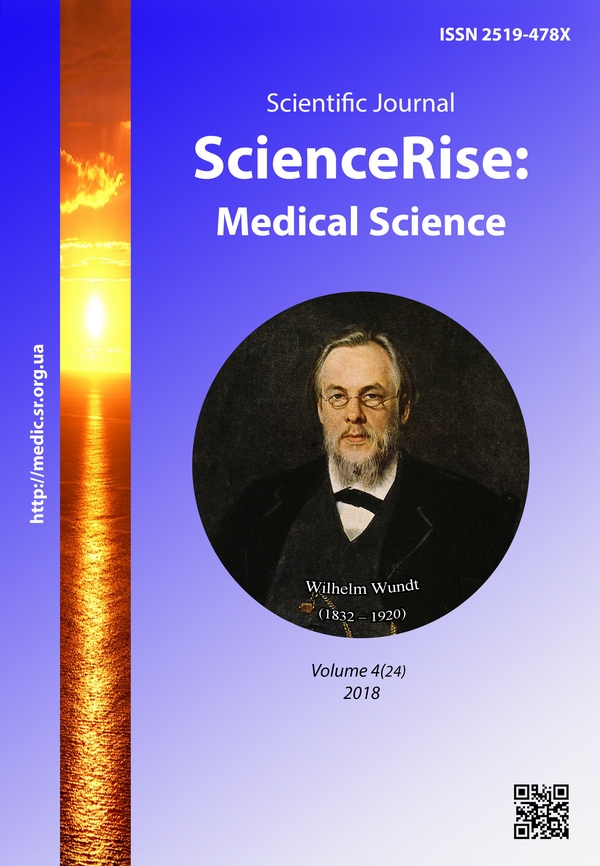Clinical differentiation of psychopathological symptomatics in depressive, maniacal and mixed types of schizoaffective disorder in dynamics
DOI:
https://doi.org/10.15587/2519-4798.2018.132560Keywords:
schizoaffective disorder, psychopathological symptoms, PANSS, YMRS, Calgary, monopolar type, bipolarAbstract
Aim of the research: conducting a comparative analysis of clinical and psychopathological features of depressive, manic and mixed types of schizoaffective disorder during active therapy at the time of the exacerbation of the disease.
Materials and methods. In the course of the study, 110 patients with schizoaffective disorder (F 25 for MIC-10) who were treated at the 1 psychiatric department of the State Institution "Institute of Neurology, Psychiatry and Narcology of the National Academy of Medical Sciences of Ukraine" for the period from 2000 to 2017 were examined. The average age of the surveyed patients was 26.0 ± 7.1, the mean duration of the disease was 5.0 ± 0.8 years.
The first group consisted of 60 patients with schizoaffective disorder, depression type MKH-10 (F25.1) and the second group - 50 patients with manic and mixed type of schizoaffective disorder for MKH-10 (F25.0, F25.2).
For the purpose of standardized assessment of psychiatric disorders and treatment effect, the PANSS scale, the Young Mania Rating Scale, and the Calgary Depression Scale (CDSS) were used. The assessment of the severity of psychopathological symptoms through these scales was performed four times during treatment in a hospital: at the first, second, third and fourth weeks of therapy. The analysis of the results was carried out with the help of methods of mathematical statistics (Student-Fisher test (t)). The data is given in the format M ± m, where M is the average value, and m is the standard error.
Results. It was found that in patients with both depressive and manic and mixed types of SAD at the time of the 4th week of active treatment of exacerbation, which actually corresponds to the discharge from the hospital, there remain certain psychopathological manifestations that are revealed by the use of assessment techniques such as the PANSS scale, Young Manic Scale, Calgary Depression Scale. In the course of the study, presented in this article, it has been shown that the depressive type of SAD on the one hand, and manic and mixed on the other, have quite distinct differences in the dynamics of symptoms at the clinico-psychopathological level.
Conclusions. Therefore, patients with schizoaffective disorder (SAD) after the quenching of acute psychotic symptoms need continued support therapy, aimed at both psychotic and affective residual manifestations
References
- Salgado, H., Carvalho, P., Almeida, N. et. al. (2014). Schizoaffective disorder a poorly understood disease. 22nd European Congress of Psychiatry. Munich.
- ICD-10 International Classification of Diseases. Version 2010. World Health Organisation. Available at: http://apps.who.int/classifications/icd10/browse/2010/en#/V
- Malaspina, D., Owen, M. J., Heckers, S., Tandon, R., Bustillo, J., Schultz, S. et. al. (2013). Schizoaffective Disorder in the DSM-5. Schizophrenia Research, 150 (1), 21–25. doi: 10.1016/j.schres.2013.04.026
- Silveira, C., Ferraz, I., Silva, S. et. al. (2014). Diagnostic stability three years after a first admission diagnosis of psychosis. 22nd European Congress of Psychiatry. Munich.
- Korenev, A. N. (1994). Clinicheskaya diferentziatzia manifestnih shizoafectivnih psihozov s preobladaniem afectivnih rastroistv [Clinical differentiation of manifest schizoaffective psychoses with predominance of affective disorders]. Journal of Neuropathology and Psychiatry, 94 (6), 45–49.
- Krasnov, V. N., Gurovich, I. Y., Mosolov, S. N., Shumkler, A. B. (2007). Psihiatricheskaya pomosh bolnim shizofreniei. Clinicheskoe rucovodstvo [Psychiatric care for patients with schizophrenia. Clinical manual]. Moscow: Medpraktika-M, 260.
- Zaitseva, Y. S., Sarkisyan, G. R., Sarkisyan, V. V., Storozhakova, Y. A. (2011). Sravnitelnoe isledovanie neirocognitivnogo profilya bolnix paranoidnoi shizofreniei i shizoafectivnim rastroistvom [Comparative study of the neurocognitive profile of patients with paranoid schizophrenia and schizoaffective disorder]. Social and Clinical Psychiatry, 21 (2), 5–11.
- Mosolov, S. N. (2008). Bipolarnoe afectivnoe rastroistvo: diagnoz i lechenie [Bipolar affective disorder: diagnosis and treatment]. Moscow: MEDPress-inform, 384.
- Anufriev, A. K. (2013). Izbrannie trudi po psihiatrii [Selected works on psychiatry]. Moscow: Publishing house "Logos", 352.
- Nuller, Y. L., Mikhalenko, I. N. (1988). Afectivnie psihozi [Affective psychosis]. Leningrad: Medicine, 264.
- Levitt, J. J., Tsuang, M. T. (1988). The heterogeneity of schizoaffective disorder: implications for treatment. American Journal of Psychiatry, 145 (8), 926–936. doi: 10.1176/ajp.145.8.926
- Vega, J. M. del R., Ayuso-Gutierrez, J. L. (1990). Course of schizoaffective psychosis: a retrospective study. Acta Psychiatrica Scandinavica, 81 (6), 534–537. doi: 10.1111/j.1600-0447.1990.tb05494.x
- Angst, J., Preisig, M. (1995). Course of a clinical cohort of unipolar, bipolar and schizoaffective patients. Results of a prospective study from 1959 to 1985. Schweiz Arch Neurol Psychiatr, 146 (1), 5–16.
Downloads
Published
How to Cite
Issue
Section
License
Copyright (c) 2018 Olga Serikova

This work is licensed under a Creative Commons Attribution 4.0 International License.
Our journal abides by the Creative Commons CC BY copyright rights and permissions for open access journals.
Authors, who are published in this journal, agree to the following conditions:
1. The authors reserve the right to authorship of the work and pass the first publication right of this work to the journal under the terms of a Creative Commons CC BY, which allows others to freely distribute the published research with the obligatory reference to the authors of the original work and the first publication of the work in this journal.
2. The authors have the right to conclude separate supplement agreements that relate to non-exclusive work distribution in the form in which it has been published by the journal (for example, to upload the work to the online storage of the journal or publish it as part of a monograph), provided that the reference to the first publication of the work in this journal is included.









